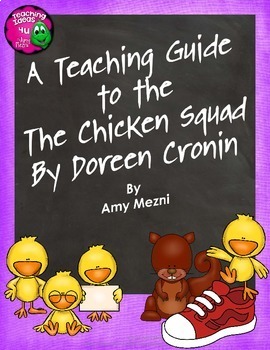The Chicken Squad by Doreen Cronin Novel Study Teaching Guide
- PDF
What educators are saying
Description
This is a 40 page novel study with answer key to The Chicken Squad: the First Misadventure by Doreen Cronin. This is a funny mystery written at a 470 Lexile. This book is great for high readers in 1st and 2nd grades, on grade level readers in 3rd grade, and low 4th grade readers.
I wrote this novel study with many vocabulary and comprehension activities, as well as a final project.
Please see the preview for the table of contents. All activities are ready to be printed and copied. An answer key is provided, as well as a rubric for the final project.
When creating these guides, the activities are written so that they could be used as individual activities or as a packet that could be given to an independent reading group. The activities are a mix of close reading questions and engaging vocabulary activities. Vocabulary activities include crossword, word searches, synonyms/antonyms, alphabetical order, dictionary guide words, and more!
This guide is broken down into chapters plus after the book activities. One chapter is covered in one day, although the classroom teacher could provide more than one class period for the activities to be completed.
If using this book as an independent work packet, copy the activities for each student and place the copies in a binder. During class, students can take the binder and easily see what they need to complete as a checklist is provided for each day. Students could be required to turn in certain activities, or the teacher could grade the activities in the binder.
If using this as a whole class activity, the teacher should simply select which activities to use and copy the desired pages.
*****************************************************************************
If you like this product, please see my other novel study teaching guides.
Boy Were We Wrong About Dinosaurs! Kudlinski Novel Study.
Magic School Bus on the Ocean Floor by Joanna Cole.
Sadako and the Thousand Paper Cranes Complete Novel Study Teaching Guide 40 Pg.
Amos & Boris by William Steig Novel Study Teaching Unit Literature Guide.
*****************************************************************************
Customer Tips:
How to get TPT credit to use on future purchases:
• Please go to your My Purchases page (you may need to login). Beside each purchase you'll see a Provide Feedback button. Simply click it and you will be taken to a page where you can give a quick rating and leave a short comment for the product. Each time you give feedback, TPT gives you feedback credits that you use to lower the cost of your future purchases. I value your feedback greatly as it helps me determine which products are most valuable for your classroom so I can create more for you. ☺
Be the first to know about my new discounts, freebies and product launches:
• Look for the green star next to my store logo and click it to become a follower. Voila! You will now receive email updates about this store. ☺
*****************************************************************************





